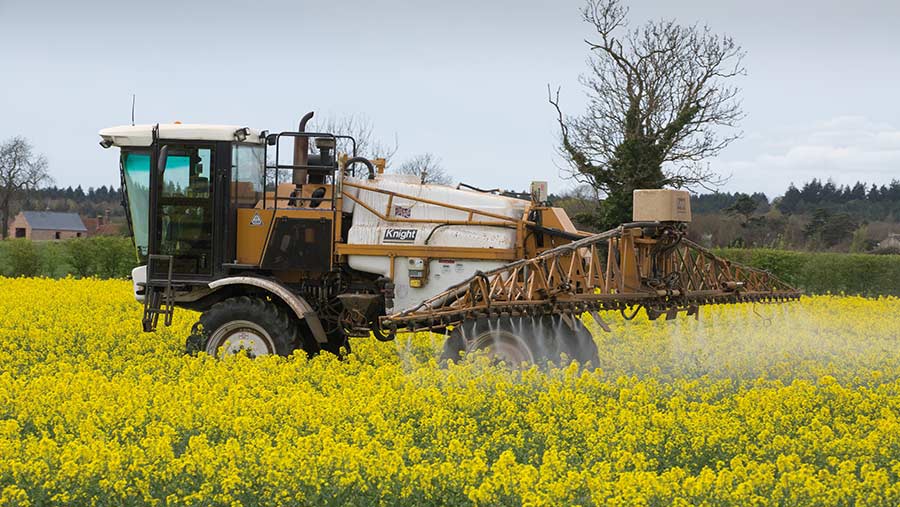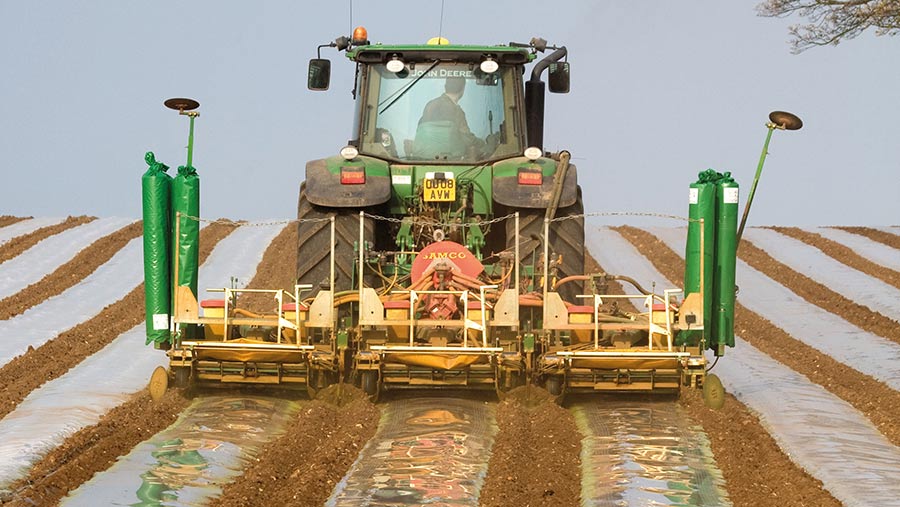Crop Watch: Spring weather cuts septoria, sclerotinia risk
 Sclerotinia sprays in OSR are being delayed until temperatures improve © Tim Scrivener
Sclerotinia sprays in OSR are being delayed until temperatures improve © Tim Scrivener The current cold, dry conditions have reduced disease pressure, especially for rain splash-spreading diseases such as septoria in wheat and sclerotinia in OSR.
Crop and grass growth is also being held back with soil temperatures still lower than this time last year.
For wheat crops in the South, this equates to being about a week behind last year.
West: Stephen Harrison
AICC/Southwest Agronomy (Avon)
Despite the cold, dry weather, cereal crop growth stages are about as expected for the time of year.
Even though there has been little rain, soil is still retaining moisture as there is not yet sufficient canopy to move water via transpiration. I expect to see rapid development through growth stages as temperatures increase.
Disease pressure is as low as I have seen it in April. Frosts have largely kept yellow rust in check and the lack of rain has stopped splash dispersal of septoria from lower leaves. Eyespot has been found at only trace levels, even in susceptible varieties such as Graham and Sundance.
Fungicides in wheat at final leaf three emerged will be slightly lower-cost protectant materials, generally including an SHDI. Lower-
potential crops with smaller canopies and reduced rooting will have an azole treatment.
A few crops established in late September on very fertile sites have not been taking heed of the weather forecast and have the tip of leaf three emerging.
Multisite question
The burning question is “to folpet or not to folpet”? When chlorothalonil was available the question never arose. Chlorothalonil was far superior and had a large price advantage.
I have studied independent research and believe folpet’s inclusion is justified on a margin-over-input cost basis and to protect the single-site actives on which we are increasingly reliant.
We do have newer materials such as Inatreq (fenpicoxamid) and Revysol (mefentrifluconazole), but to maintain their benefits they should still be used as protectants, only relying on their eradicant properties in extreme situations.
Winter oilseed rape is now flowering. Apothecia germination has been disrupted by the cold weather, so sclerotinia sprays are being delayed until temperatures improve.
Rain splash is needed for spore dispersal, but temperatures only need to be above 7C for 23 hours for infection to occur. I refuse to believe that no rain will fall during flowering, so I will definitely be treating.
South: Iain Richards
Agrii (Oxfordshire)
The second half of March and run-up to Easter gave us just the conditions we were waiting for to get all our spring crops drilled – with the exception of OSR and linseed, which we won’t drill until it’s warmer – into decent seed-beds.
With mid-April soil temperatures of just 6C against 9.5C this time last year, though, neither they nor spring barleys on lighter ground sown almost two months ago are going anywhere fast.
This and very little rain for the past six weeks mean our spring barley focus has been on early nutrition and growth manipulation for rooting and tillering.
Our later drillings had more of their nitrogen in the seed-bed and everything has now had its full allocation. So, they shouldn’t lack for N as they race to catch up – as they surely will, once things warm up.
Biostimulant Nutri-Phite and low-temperature active chlormequat have been our go-to spring barley supports before the four-leaf stage, accompanied by fenoxaprop to deal with wild oats wherever necessary and magnesium/manganese where needed.
The cold spring means leaving their main herbicide treatment until T1 will be more important than ever to catch late-germinating broad-leaved weeds. It will accompany our preferred prothioconazole/bixafen co-formulation, plus a strobilurin and folpet (for its value against ramularia).
Where it stays dry, extra manganese and magnesium will be vital on soils known to give us supply problems. For crop safety, though, we’ll hold off on any further plant growth regulator until the T2 wherever we can.
Week behind
Our wheats are a week behind where they were last season, with leaf four only recently fully emerged and T0s completed. They’ll catch up. But leaf three emergence and T1 certainly won’t be early in most cases. So we should have a much more manageable T1-T2 gap (maybe just two weeks) to adapt to what could be rapidly changing crop and disease conditions.
We addressed the main differences between earlier- and later-drilled wheats with very different T0 approaches that kept a firm lid on disease on the one hand and supported plant growth on the other. And all our crops have had their second nitrogen split, taking applications to 140kg/ha.
Few rain splash events so far, lower temperatures and some decidedly susceptible varieties in the ground mean yellow rust remains our most important T1 driver. So, we’ll be saving our “big septoria guns” for T2 to counter the virtual inevitability of wetter – as well as warmer – weather.
Our main T1 base will be the tried-and-trusted combination of bixafen with prothioconazole, topped up with tebuconazole or pyraclostrobin where the yellow rust risk is highest. This should be quite sufficient to deal with the current septoria pressure, while giving valuable physiological benefits in the dry.
We will add trinexepac and chlormequat as the second half of our split plant-growth regulator programme and, if it stays dry, we won’t hesitate to include the foliar magnesium we find so valuable in supporting chlorophyll production while continuing to hope for rain – but not too much, please.
East: Toni Tunmore
Agrovista (Norfolk/Suffolk)
Recent frost, and even snow, stalled crop growth. At the time of writing this I still have wheats with very little growth upwards, but rust pressure has built. Wheat T0s programmed with these rusts in mind should now have been applied, and, hopefully, plant growth regulator applications were managed, successfully avoiding the frosts last week.
Spring drilling is largely complete. It is hard to believe given the previous autumn and winter rainfall, but some rain showers would now be warmly received. Most seeds have, however, found moisture, and emergence is largely even, but has been challenging on some of the heavier land.
Earlier-drilled sugar beet emerged into less-than-ideal frosty conditions. The first worry was for the beet plants themselves. Once this worry was answered, thoughts turned to first herbicide timings.
These were tricky and had to be delayed for warmer weather. Luckily, weeds were slow to appear, so only a handful of weeds will have got away. But better a slightly weedy beet crop than no crop at all.
Flowering OSR
OSR is now turning the countryside yellow. With thoughts in the coming weeks turning towards mid-flower sclerotinia sprays, and possibly seed weevil, please keep bee safety in mind. Only treat seed weevil if the threshold is met; one a plant in the South and 0.5 a plant in the North. Check labels and tank-mixing information if you need to mix an azole and pyrethroid during flowering.
Also ensure all insecticides are applied outside of bee-foraging time. Early morning/late dusk is best.
Growers are urged to make use of the BeeConnected website and keep local beekeepers notified when insecticides will be applied to crops. Farmers can register their intention to spray an insecticide and then identify a field they plan to spray by dropping a pin onto an on-screen map.
Registered beekeepers are then notified via email. Use isn’t restricted to just OSR flowering sprays. This could also be used when planning to spray a crop with a flower margin or conservation strip neighbouring the field. As an industry it is important we do all we can to protect our bees and pollinators.
North: Helen Brown
Hutchinsons (Cumbria)
April has been exceptionally cold and dry in Cumbria, with the month’s average air temperature to date at Penrith being 3.6C, compared with a 10-year average of 7C.
Together with only 2.2mm of rain so far this month, it has slowed crop and grass growth significantly.
Winter wheats and barleys are at growth stage 30-31. Winter barleys have now received or are due to receive T1 applications. Rhynchosporium and brown rust infections are present in most crops and, although the recent drier and cooler weather has slowed the spread of rhynchosporium, it is important to control these diseases early to protect tiller numbers and yield.
The dry weather has provided good conditions for spring barley drilling over the past month, which is about 80-90% complete, including our spring barley drilling trial at our Cumbrian trial site.
The trial is comparing a one-pass Mzuri strip-sill machine with a plough and combination drill method, and looking at the use of placement fertiliser drilled on 13 April.
Dry conditions
If the dry weather continues, it will be interesting to see the effect of drilling method on moisture retention in this light, sandy loam.
Some spring barleys have started to emerge and are at the one-leaf stage. I have decided against using pre-emergence herbicides in spring barley crops due to reduced effectiveness in these dry conditions and will target weeds after emergence.
Cool soil temperatures are slowing grass growth significantly, and spring dock control should be delayed until docks are actively growing, dinner plate-sized and have healthy leaves rather than red overwintered leaves.
On lighter land, grass will start to suffer if we do not receive rain soon and this will effect first-cut yields.
The past fortnight has been busy for maize drilling under film. Ideally, soil temperatures should be 8-10C and rising for successful maize establishment.
Our maize trial site was drilled on 16 April and if the current cool temperatures continue, we expect to see an even larger than usual difference in early vigour between the maize under film and in the open at
the site.

© Tim Scrivener

